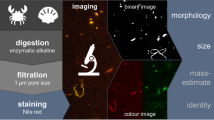Summary
A new method of carrying out confirmatory tests is proposed. Colourless or slightly yellow anion-exchange resins are used as media for the tests. Both sensitivity and selectivity can be increased because of the well-known properties of ion-exchange resins. Co(IT) and Cr(VI) can be detected by very simple procedure; to a drop of sample solution a few particles of anion-exchange resin (RCl form) are added and after some time a drop of reagent [ammonium thiocyanate to Co(II) and hydrogen peroxide to Cr(VI)] is added. The change in colour of the particles of ion exchange resin is observed with the aid of magnifying glass. The limit of identification of sky blue colour of the cobalt complex is 0.16μg and its limiting concentration is 1 ∶ 1.3×105. The limit of identification of violet-blue colour of the Cr(VI) complex is 0.3μg and its limiting concentration is 1 ∶ 105. Ge(IV) can also be detected easily by a slightly modified method; the particles of an anion-exchange resin with low cross linking are previously impregnated with hematoxylin solution and those yellow particles are transfered to a drop of sample solution. The limit of identification of the red-violet colour of the Ge(IV) complex is 0.005μg and its limiting concentration is 1 ∶ 6×106. Interfering substances, such as Fe3+ and Bi3+, can be removed completely with the aid of a cation-exchange resin which is added just before adding the particles of anion-exchange resin. The limiting proportions are also described in each case.
Zusammenfassung
Eine neue Methode für die Ausführung analytischer Nachweise wird vorgeschlagen. Hierzu werden farblose oder hellgelb gefärbte Anionenaustaiischer verwendet. Die Empfindlichkeit und Selektivität läßt sich infolge der bekannten Eigenschaften von Austauscherharzen steigern. Kobalt(II) und Chrom(VI) können in einfacher Weise nachgewiesen werden; zu einem Tropfen der Probelösung gibt man wenige Körnchen des Anionenaustauschers (RCl-Form) und setzt nach einiger Zeit einen Tropfen Reagens [Ammoniumrhodanid für Kobalt(II) und Wasserstoffperoxyd für Chrom(VI)] zu. Die Farbveränderung der Ionenaustauscherpartikel wird mit einem Vergrößerungsglas beobachtet. Die Erfassungsgrenze für die himmelblaue Farbe des Kobalt(II)komplexes beträgt 0,16μg, die Grenzkonzentration 1 ∶ 1,3·105. Die Erfassungsgrenze für die violettblaue Farbe des Chrom(VI)-komplexes 0,3μg, die Grenzkonzentration 1 ∶ 105. Germanium (IV) läßt sich ebenso leicht nach einer etwas abgeänderten Methode nachweisen; die Teilchen eines Anionenaustauscherharzes mit geringer Kettenverzweigung werden zunächst mit einer Hämatoxylinlösung imprägniert, dann bringt man diese gelb gefärbten Körnchen zu einem Tropfen der Probelösung. Die Erfassungsgrenze für die rotviolette Farbe des Germanium(IV)komplexes beträgt 0,0005.μg, die Grenzkonzentration 1 ∶ 6·106. Störende Substanzen, wie Eisen(III) und Wismut(III), können mit Hilfe eines Kationenaustauschers, den man unmittelbar vor dem Anionenaustauscher zusetzt, vollständig entfernt werden. Die Grenzverhältnisse werden für jeden dieser Nachweise angegeben.
Résumé
L'auteur propose une nouvelle méthode permettant d'effectuer des tests de confirmation. A cet effet, on emploie des résines échangeuses d'anions incolores ou légèrement jaunâtres. Les propriétés bien connues des résines échangeuses d'ions permettent d'obtenir une sensibilité et une sélectivité accrues. Le cobalt(II) et le chrome(VI) peuvent être décelés de façon très simple: à une goutte de la solution à étudier on ajoute quelques particules de résine échangeuse d'anion (de forme RCl) puis, après un certain temps, une goutte de réactif (thiocyanate d'ammonium dans le cas du cobalt II et eau oxygénée dans le cas du chrome VI). On observe à l'aide d'une loupe le changement de coloration des particules de la résine échangeuse d'ions. Pour le bleu ciel du cobalt, la limite d'identification est 0,16μg et la concentration limite 1 ∶ 3×105. Pour le complexe bleu violacé du chrome(VI) elle est de 0, 3μg et la concentration limite 1 ∶ 105. A l'aide d'une légère modification de la méthode il devient également possible de déceler Ge(IV): les particules d'une résine échangeuse d'anions à chaîne peu ramifiée sont préalablement imprégnées d'une solution d'hématoxyline; elles ont alors une coloration jaune et sont introduites dans une goutte de solution à étudier. La coloration rouge violacé du complexe de Ge(IV) permet d'atteindre une limite d'identification de 0,005μg et une concentration limite d'identification de 0,005μg et une concentration limite de 1 ∶ 6×106. Les substances gênantes telles que Fe3+ ou Bi3+ peuvent être éliminées complètement à l'aide d'une résine échangeuse de cations que l'on introduit immédiatement avant l'addition des particules de la résine échangeuse d'anions. Les proportions limites sont également indiquées dans chaque cas.
Similar content being viewed by others
References
M. Fujimoto, Bull. Chem. Soc. Japan27, 48 (1954).
M. Fujimoto, Bull. Chem. Soc. Japan27, 347 (1954).
H. Kakihana andT. Murase, J. Chem. Soc. Japan75, 907 (1954).
H. Kakikana, Y. Mori andK. Yaprasaki, J. Chem. Soc. Japan76, 215 (1955).
Author information
Authors and Affiliations
Rights and permissions
About this article
Cite this article
Kakihana, H. Microchemical detection of several elements using ion-exchange resin. Mikrochim Acta 44, 682–688 (1956). https://doi.org/10.1007/BF01262109
Received:
Issue Date:
DOI: https://doi.org/10.1007/BF01262109




